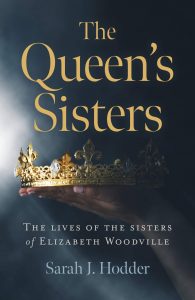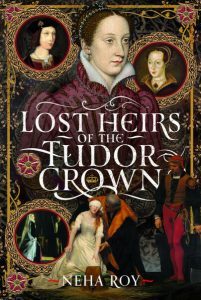Sarah J Hodder’s first book, ‘The Queen’s Sisters: The Lives of the Sisters of Elizabeth Woodville’ was published by Chronos Books in March.
Buy ‘The Queen’s Sisters’:
Follow Sarah on Social Media
Twitter: @srhjyn8
Website: Under The Medieval Oak Tree
Facebook: Under The Medieval Oak Tree – S J Hodder
Many thanks to Sarah for answering my questions.
Why did you choose this subject for your book?
I chose to write about Elizabeth Woodville’s sisters for quite a simple reason really – it was a book that I wanted to read. I have always been fascinated by Elizabeth’s story and whenever I read books about her life, her brothers and parents were often mentioned in some detail but her sisters were only ever given a passing mention – mostly concerning their marriages, how they were ‘married’ off around the time of Elizabeth’s coronation and how this attributed to the Woodville reputation of being upstarts and social climbers. I wanted to know more about these women and their lives.
What does your book add to previous works covering this subject?
As far as I’m aware there are no specific books on Elizabeth’s sisters, but overall if you are interested in the story of Elizabeth Woodville and the Woodville family in general then this book fills a gap by giving us a glimpse into the lives of her female siblings, who are just as important members of the family as her brothers and parents, in my opinion. I appreciate the reason they have not been written about before is because there really is such a small amount of information on them – when I started my research I only knew their names and some other minor details; for example that Anne Woodville had served as one of Elizabeth’s ladies. But I was determined to find out what I could and set myself the task of researching their stories by looking for any facts that could be found on them – such as the families they married in to and the places they lived. At the beginning I was not even sure if it would be possible but once you start piecing snippets of information together, you can start to get a shadowy picture of their lives. The book is really a series of chapters that are effectively mini biographies of each women and with the known facts and a small application of imagination, I hope the Woodville sisters are brought to life once more.
Which sister was the most interesting to write about?
Katherine Woodville was always my favourite sister, and although she was the one I knew the most about before I started researching, I still discovered much that I didn’t know, including the fact that during her marriage to Jasper Tudor, she would have visited and stayed at two of his properties – Minster Lovell and Sudeley Castle, two of my most favourite places to visit. Sudeley is of course today mainly associated with Henry VIII’s last wife, Katherine Parr, and Minster Lovell originally belonged to the Lovell family and was inhabited by Francis Lovell, one of Richard III’s closest friends. Both these locations I have visited more than once and to find out they had an association with Katherine was both a surprise and a joy.
As the baby of the family, Katherine was the one whose life really was dictated by her sister marrying the King. She left her previous life behind at such a young age that her memories of the Woodville family home at Grafton were probably few and far between. She had three marriages and really led a rollercoaster of a life, much of it not necessarily under her control. Her life also ended in such a bittersweet way, having finally married for love and yet dying just fourteen months later. The comparison with Katherine Parr, who also had several husbands, and died shortly after marrying the man she loved, particularly with the Sudeley connection, was for me both striking and poignant.
What surprised you most researching this book?
I think what surprised me most was how their lives had left footprints into other stories we know from our history books. I could have started researching the sisters and found that they had completely faded into the annals of history without trace. But for instance Jacquetta’s daughter married into the well-known Stanley family, famed for their actions at Boswell, Anne Woodville’s granddaughter married William Parr, brother of Queen Katherine and scandalously left him and Mary’s granddaughter married William Brereton, one of the gentlemen accused of adultery with Anne Boleyn and executed alongside her. This is the kind of history I love – when you discover connections and ancestry between people that you never knew existed.
Which sister was the most difficult to write about?
I think Jane was probably the hardest sister; she was the sibling most in the shadows. I had initially thought it would be Jacquetta – indeed she was the sister I began writing and researching first. My plan had always been to start with the woman I thought would be the most difficult. If I couldn’t write a chapter on her then there would be no project, and I knew absolutely nothing about Jacquetta. So, when I discovered that she was already married by the time of Elizabeth’s union with Edward, this was for me hugely exciting. It meant that not all Elizabeth’s sisters were married off and immediately broke the ‘collective story’ that was told about them. Jane was second on my list and ultimately she did prove much harder, possibly because her husband died young so his story ended early on, and there is a strong possibility that she remained childless, which meant there were less footsteps to follow. But in actual fact, with both Jane and the elusive (and very possible non-sister Martha) both being real enigmas, that leaves, for me, the intriguing possibility that one day we may discover more and that there is still more to tell.
Did the marriages of Elizabeth’s sisters form the successful alliances that Edward IV wanted?
Edward and Elizabeth are often heavily criticised for arranging marriages for her unwed sisters to eligible gentlemen, but actually it was a sensible move and they would have been foolish to do otherwise. Marriages were often made to forge alliances between families and the Woodville girls would always have had suitable families selected for them once they reached a marriageable age. Kingship/Queenship brings with it a huge responsibility and, I imagine, a loneliness at times; constantly surrounded by people, but unsure of whom you can trust. So to bring some of the great families of the land closer to the royal family through marriage was a hugely prudent thing to do. Elizabeth’s sisters, many of whom were quite young when they married, were matched with the sons of families who were already Yorkist supporters, but as they grew into men, their husbands remained supporters of the King and his family. The detractors of the Woodvilles often label this as social-climbing because their chosen husbands were perhaps now higher up the social ladder than they would have achieved before Elizabeth became Queen. But Edward was a strong King and would have been heavily involved in their choice of husbands, because he was aware that through these marriages, it would bring him a tight circle of supporters that he could hopefully count on when needed. In the end, many of the troubles Edward faced during his reign came from inside his own family, when his brother Clarence and his cousin Warwick (who was so instrumental in making him King) turned against him. A noticeable example that allegiance was never guaranteed, so to form as many alliances as possible through these early marriage unions completely made sense. As far as I am aware, all of these men fought with and remained loyal to Edward throughout his life so in the end it was a decision that served him well.






































